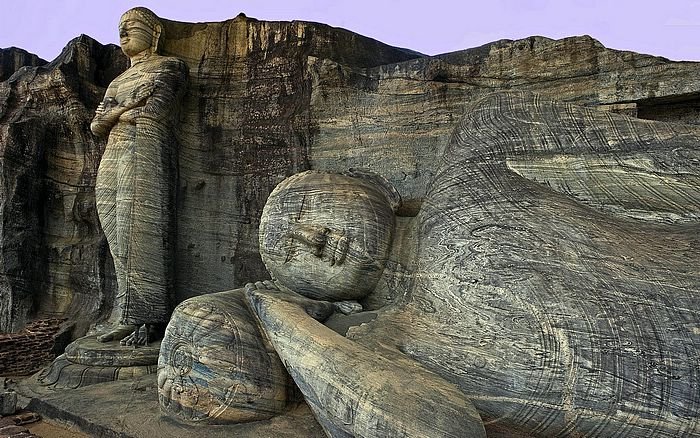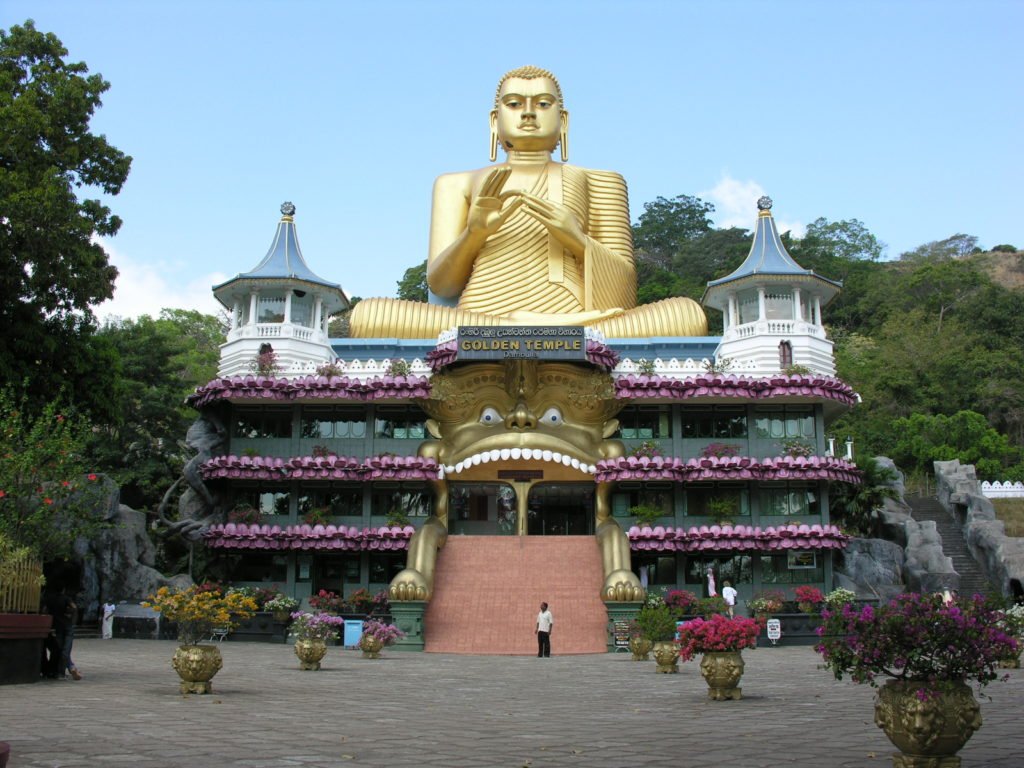Where am I : India Tour Packages » Most Popular Packages » Polonnaruwa Tour Packages
View Details

Destinations Covered : Colombo » Pinnawela » Dambulla » Sigiriya » Polonnaruwa » Sigiriya » Kandy » Nuwara Eliya » Beruwala
View Details

Destinations Covered : Kandy » Dambulla » Kandalama » Sigiriya » Anuradhapura » Polonnaruwa » Colombo
Visit in Polonnaruwa
Polonnaruwa is a popular tourist destination for discovering the island's traditional architecture and art. It is located on the territory of the so-called "Golden Triangle," which, in addition to the ruins of Polonnaruwa, includes the religious complexes of Anuradhapura and the highly aesthetic objects of Kandy. All three former capitals of Sri Lanka are often combined into one sightseeing tour. Hotels offer it to foreign tourists as one of the first tours to get acquainted with the island's history. But you can visit Polonnaruwa on your own, having made a route to places of interest in advance. This will help a brief review of archaeological and natural monuments proposed in the article. By the way, Polonnaruwa was the inheritance of the rulers of Sri Lanka from the 10th to the 12th century AD. Buddhist monks built the city in the 3rd century BC. Since those times, an artificial reservoir and ancient temples have been preserved.
What is fascinating about the city Polonnaruwa?
Currently, the city is conditionally divided into two parts: the old one, guarded, and the new one, where hotels and restaurants are located. But you need to understand that loud music is not heard on the streets of the modern part and discos do not work. An atmosphere of complete solitude with oneself reigns. And this is understandable. In this direction, every year, countless pilgrims who want to touch and look at the shrines erected before our era arrive. And given the careful attitude of residents to Buddha statues, there is even a list of rules that must be followed when visiting these attractions. Many guests note the local lake Samudra Parakrama. At one time, it was artificially created by King Parakramabahu to irrigate rice fields. Here you can often see people resting, quietly spending time with friends and relatives.
History-rich Polonnaruwa
A trip to Sri Lanka must begin with a visit to its medieval capital, Pollonaruwa. A visit to this mysterious city will give a lot of impressions to admirers of ancient history. To fully immerse in past centuries, you should look into the monumental Archaeological Museum. Here, household items, intricate jewelry, old coins, and many other artifacts of ancient generations are stored. The museum depository also opens its extensive library to lovers of antiquity, where you can get acquainted with cultural and historical works about Sri Lanka and Polonnaruwa. You can also purchase tickets to visit other memorial buildings of the city at the museum's box office. Many masterpieces of architectural art are scattered throughout the city, including ancient temples, palaces, and public buildings. Among all the stunning temples of Polonnaruwa, the most interesting for curious tourists is Hotadage, a building erected in the 12th century and blessed by the king, decorated with wall frescoes and majestic statues. On the city's outskirts is a 13-meter, striking sculptural composition with the participation of the Buddha, other Hindu gods, and floral ornaments. All sculptures are located in the courtyard of the mystical temple of Lankatilaka. Compete for the presence of the best statue of Siddhartha Gautama can stone temple Gal Vihara, containing four granite statues of the great founder of Buddhism. After enjoying the religious monuments of medieval Sri Lanka, the traveler is advised to continue his tour and visit the ruins of the royal palace. On its territory, there was once a flowering garden and a high-tech pool for its time, the water of which came from an underground canal system and was scented with jasmine flowers. Also, the area of ??the royal estates included many sectors for entertainment and research activities.
Best destinations of Polonnaruwa
Polonnaruwa in Sri Lanka is considered one of the best-preserved ancient cities on the planet. It was declared a World Heritage Site, and due to its abundance of historical remains, there are numerous places to see in Polonnaruwa. Polonnaruwa is one of the cleanest cities in the country. The green surroundings are home to incredible ancient buildings, the Parakrama Samudraya, and a friendly and hospitable population.
The King Parakramabahu Statue
The King Parakramabahu Statue is located in the region of the Pothgul Vihara complex and was built by King Parakramabahu I. The Parakramabahu statue is rarely assumed to be a portrait of the noble king. Also, he is sometimes considered a sage, a statue of Pulathi Rishi. The figure itself is in the form of a giant rock from the 12th century AD. It is one of the well-crafted stone statues of this time. About twelve feet tall, this sculpture is of a severe but wise-looking man with narrowed eyes and a sad smile as he holds what most think to be a manuscript in his arms at chest height. The man is bare-chested, except for a thread that runs over his left shoulder. His burden is carried by one of his feet and some of both. Archaeologist Prof. Senarath Paranavithana concludes that this statue is an expression of power and nobility, regardless of the person's unique identity and whether or not it is an official portrait of someone from the time. It is one of many cryptic and thought-provoking sculptures at Polonnaruwa.
Kumara Pokuna
Near the palace, and probably where you will start your visit, is the royal bath, the Kumara Pokuna. This area was probably a part of the Royal Garden of Joy of Parakramabahu. Water, which might have been scented, flowed into the bath on the sides, and the solid masses of stone ensured that the water was cold even on the hottest day. Right next to it, the remains of the walls make one believe there was a room where one could change.
Unique-shaped Pabalu Vehera stupa.
The Pabalu Vehera stupa was built at the behest of the queen. It is surrounded by four houses of Buddha images, oriented to the four cardinal directions. The sanctuary was believed to be built before recognizing Polonnaruwa as the state's capital. But at one time, it was the center of the city. For example, the main street of the ancient city led to Pabal Behera, which today has turned into a narrow path overgrown with grass and weeds, and used to bring numerous pilgrims here.
Wild elephants
Families of wild elephants can be seen on the shores of the great lake of Polonnaruwa in the early morning and late afternoon. Something incredible to witness since you do not see these animals tied up or with marks of having received sticks endlessly to be docile. These elephants can only be seen keeping their distance since, like any wild animal, they can attack.
Sath Mahal Prasadaya
Sath Mahal Prasadaya is a seven-story pyramid-shaped building and is believed to be an unusually shaped stupa built during the Polonnaruwa period. Stupas similar to this one can be seen in Cambodia and Thailand, so that they may have been built as a place of worship for Cambodian soldiers working under the king's orders. The building has four entrances on all four sides and a staircase to reach the upper levels.
The Royal Palace
The Royal Palace is called Vijayotpaya, a seven-story structure built by King Parakramabahu the Great at Polonnaruwa. It is argued that these must have been used for wooden beams that are currently rotten. These wooden shafts had to be supported to support the wooden foundations.
The Vatadage- the most spectacular and photogenic
It is one of the spectacular and photogenic of the complex, at least for us. The Vatadage was built to protect a miniature stupa and features two stone platforms decorated with elaborate carvings. The stairs leading to the cardinal points are made of carved stone, such as the sandakada pahanas, considered the best examples of this type of architectural element. The sanctuary is completed with stunning moonstones.
Minneriya National Park- The home to different species
The Minneriya National Park is home to different species of both flora and fauna. Its most famous inhabitants during the dry season are the native Sri Lankan elephants, who come in dozens to drink from a water reservoir created by King Mahasen more than 1,000 years ago. But the elephants are only their most famous inhabitants. We can find leopards, lemurs, macaques, cormorants, and pelicans.
Rankoth Vehera
Rankoth Vehera is the fourth largest stupa in the country after Ruwanveli Seya, Jetawanarama, and Abhayagiriya in Anuradhapura. Built-in brick by King Nissanka Malla is 55 meters high and 185 meters in circumference. Its four entrances point to the four cardinal points and a stone with inscriptions on the construction work supervised by the king completes the largest stupa in Polonnaruwa.
The Menik Vihara stupa
In the northern part, right next to the wall of the Archaeological Park, there is the Menik Vihara stupa. Translated from Sinhalese, this means a sanctuary covered with precious stones. During the excavations, a considerable number of precious stones were indeed found. The temple was built on a hill, surrounded by stone walls. A staircase decorated with bas-reliefs of sacred animals leads to the main entrance. Below it is guarded by stone guards. Dagobah was initially built under the roof. Time and tropical downpours have taken their toll, leaving the complex dilapidated. Preserved - terracotta sculptures of lions, installed around the "pesala valalu," a carved door frame, several house images, and an ancient Bodhi tree.
Aangamedilla National Park
The Aangamedilla National Park was created in its day to protect the water reserves of Parakrama Samudra, a lake that provides water to different areas. The park is particularly arid in the dry season and humid in the rainy season, which is why it has a fascinating mixture of vegetation. In addition, it is the home of the Ceylon Rooster, the national bird of Sri Lanka, which lives with many other species such as langurs, deer, elephants, sloths, and the Sri Lankan leopard.
Nelum Pokuna pool
Nelum Pokuna is an ancient swimming pool with a novel object built by early Sri Lankan architects. It is located in the ancient capital of Polonnaruwa in the North Central Province, Sri Lanka. The pond got its title due to its design which looks like a blooming lotus flower. This pond looks a bit like the other ponds in the ancient city of Polonnaruwa, built out of rocks. This Lotus Pond has also strengthened the architectural design of the Nelum Pokuna Theater in Colombo.
Council Chamber of King Parakramabahu
The Council Chamber (Raja Sabahawa) of King Parakramabahu is one of the best-preserved structures in the royal palace complex. It consists of three levels of 22 meters long by 10 meters wide, adorned with sculptures of lions at the end of the stairs, sculpted elephants in different positions, elegant pillars, and a moonstone. In this room, it is where the king met to discuss matters of state.
Cuisine and restaurants
The national cuisine of Sri Lanka is diverse. Tropical fruits, baked with meat or fish, seasoned with spices, spices, and herbs - all this flavor variety can be enjoyed in Polonnaruwa. It is safest to dine here in hotels or guesthouses. Popular among tourists is Polonnaruwa Rest House, located in the most beautiful place in the city near the main attractions of Polonnaruwa, on the lake. You can also go for a bite to eat at the New Araliya Sinhala Hotel, which also has European and traditional cuisine. Of particular note are kotthu rotti or pancakes baked with meat and vegetables. The city also has a cozy cafe called Corner Cafe, located in the old city opposite the sitting Buddha statue, not far from the lake. All passing buses stop here, so the place is always trendy among tourists and locals. For breakfast, you can have delicious pastries with sweet tea, decadent donuts, and rotti with different sauces.
Tips for seeing Polonnaruwa
Since we are talking about a sacred place, it is advisable to dress appropriately.
- First, it is good to wear long trousers, both men and women. The latter must then have their shoulders covered: either wear a t-shirt or bring a shawl or scarf to wear at the right time.
- While in the temples (or in what remains of them), you will have to take off your shoes. If you decide to wear sandals, remember to keep some socks handy.
- The stones you will walk on can become incandescent in the central hours of the day, and you risk burning your feet.
- Finally, if you decide to take pictures of yourself in front of the Buddha statues, remember to never turn your back on them; you will have to put yourself in profile, so you will not risk being scolded by some bar passing by that moment or by your guide.
- Speaking of guides, we always opposed to visiting a site of this importance and complexity on my own. Without a guide, you risk losing the essence of its history and religious significance.
- Indeed, the entrance ticket is already quite expensive, since it is around 25 dollars for adults, and it is true that the presence of a guide would increase the cost of the visit; but I think it's very well spent and worth it.
When to visit Polonnaruwa?
Polonnaruwa has a tropical climate with a good chance of rain at least six months out of the year. The best times to visit Polonnaruwa in terms of weather are in July, August, and January. In March, there is the circumstance that it is a month with less tourist influx than usual so that visits can be made more calmly. Between October and December, the chances of rain increase considerably compared to the rest of the year.
How to get to Polonnaruwa?
By train
It is most convenient to move around the country using the developed railway network. Cars are divided into several classes. You can comfortably relax in first-class sleeping cars, enjoying the picturesque views of Ceylon, or book second-class tickets, which are no less cozy than first class.
Polonnaruwa is on the Colombo -Batticaloa route. You can get to the hotel using local transport services - a tuk-tuk.
By bus
In addition, Sri Lanka is covered by a network of bus routes, making it easy to get to the country's most remote corners. From Colombo, there is a direct bus to the city of Polonnaruwa. Travel time is about 6 hours.
Buses in the country are run by both state-owned CTB companies and private ones, while the cost of tickets for both is the same. It is worth it because the buses are narrow and old, the seats are often broken, and the air conditioners practically do not work.
How to move around the Polonnaruwa site
Polonnaruwa covers an extensive area, so getting around on foot is feasible, but it is certainly not the most comfortable solution. The problem is not only the distance to cover, but the fact that temperatures at a particular time can be very high, and the intense heat could create discomfort. The alternatives are to rent a tuc tuc or bicycles, obviously negotiating first on the price, or better still to travel by car as we did.
Conclusion
Discover the variety of attractions of Polonnaruwa during your vacation in the Cultural Triangle of Sri Lanka. From visiting the iconic remains of the ancient kingdom, such as King Parakramabahu's Palace, to venturing into exciting national wildlife safari parks such as Minneriya, Angammadilla, and Wasgamuwa. There are a variety of attractions to visit while traveling to Polonnaruwa.
Sri Lankan technicians and artisans built unique and breathtaking constructions in ancient society. Formulated with bricks and carved with stones, these productions observed in the ancient city of Polonnaruwa continue to amaze the world. Here you can see the most beautiful places to visit in Polonnaruwa. If you organize your trip to Sri Lanka, we recommend our Guide to Sri Lanka, so you don't miss anything.
Speak to our Experts!
Instant Quote, Best Deals - 100% Customizable, Includes hotels + car + guides Cost depends on various factors like, number of people you are, travel dates, category of hotel and transportation etc.Drop your Inquiry to get the best deals as per your requirements. 100% Satisfaction Guaranteed. Rated 5* in TripAdvisor.



